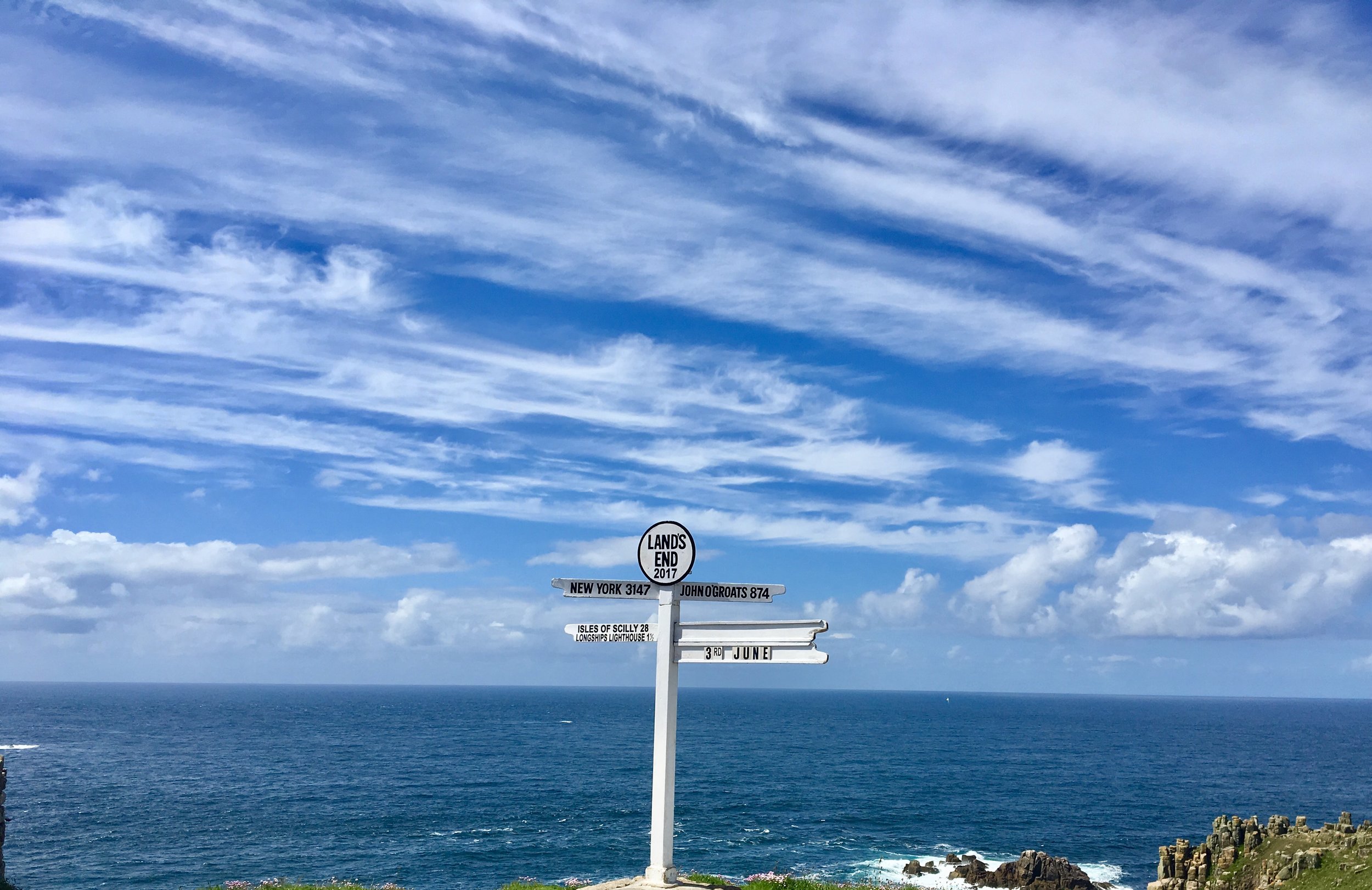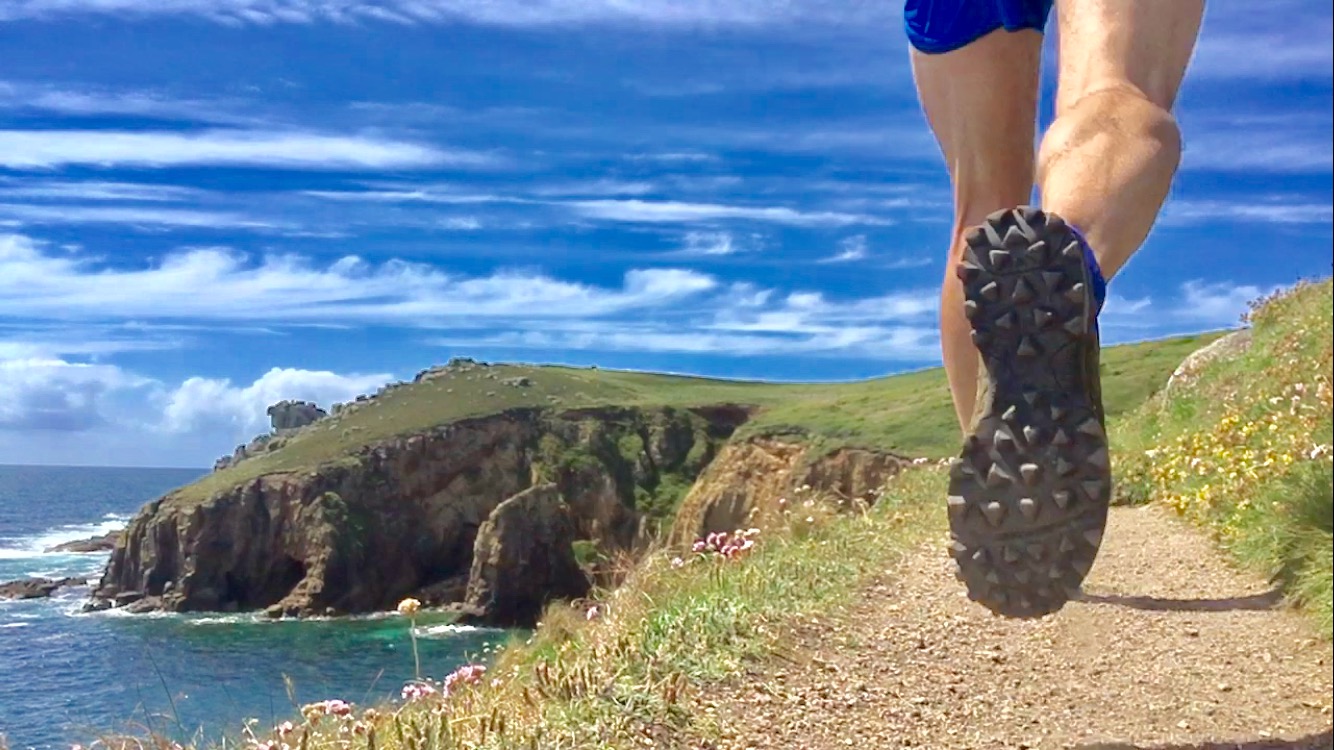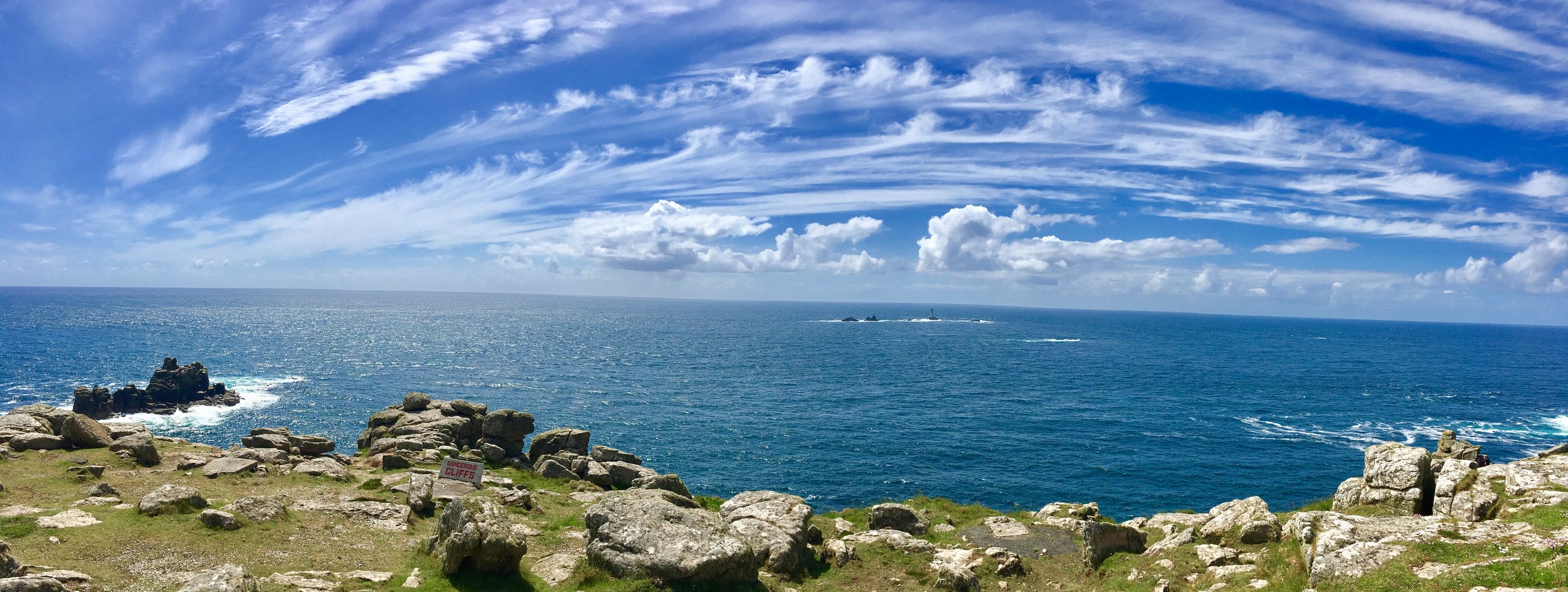So I crossed the border. Foreigners. These heathens put the jam on first, if you can believe that? By the time I arrived at Plymouth, the idea of running the whole path had fully formed in my mind. Having linked all of South Devon I was pretty excited to do the same thing across southern Cornwall and continue my journey, gradually adding to the little, but ever growing red line I was drawing on my home-printed map. The miles from Plymouth to Lands End were not plain sailing though, they taught me a few lessons, and forced me into new strategies and techniques. This section made me look much more closely at training, nutrition, and rehab, and this part of the blog will reflect that, so for anyone who is curious about the basic logistics of kit and training - read on, for those that aren't - there was still a huge amount of beauty (eventually) to continue the inspiration as well. Ultimately, Cornwall did not disappoint.
Today's soundtrack:
Plymouth to Looe was the first leg. I was pretty confident of doing 20+ miles each time by now. Blasé perhaps, maybe even complacent? From a scenic point of view I was a tad - just sayin' - disappointed after the constantly beautiful South Hams. But physically I felt more able to take some big bites out of the overall distance. That's not to say that these first two or three runs weren't pretty:
Freathy. Spot the lone SUP'er
Long Sands
Long glorious stretches of near endless golden sand. Surfers strolling from their vans, boards under arms, wetsuits rolled to their waists, barefoot on tarmac. There was quite a nice relaxed atmosphere, and some lovely easier running, just not the drama of the hills of South Devon. It wasn't as punch you in the face spectacular, so for some reason I was disappointed. But maybe that's just me.
"So we are history, a shadow covers me, the sky above ablaze"
Lantivet Bay. Been a grey old morning until the cloud past by and the world turned from black and white to colour. So beautiful I stopped chewing my sandwich.
I'm not going to go into too much detail about the rest of the route here, because I want to talk mostly about training and gear in this chapter; but suffice to say I found a long stretch - Plymouth to Lizard almost, fairly samey and relatively - relatively - bland. Plymouth to Looe, Looe to Charlestown, Charlestown to Falmouth, they all had their moments and highlights, and none of them were ugly runs, by any means. I just found this to be a bit like a treadmill. I was hankering a bit for more of the iconic stuff: more Kynance Cove, more Bedruthan Steps, more Porthcurno. Might have just been me, spoiled by Devon and the South Hams maybe, but in my head I was ticking these stages off. And then at Helford Passage; a mini disaster, an injury - and now with hindsight I wonder if this lack of inspiration and motivation was a contributory factor? Like I was grinding through the miles rather than flying along, and the body didn't like that.
Falmouth to Lizard Point looked great on paper. I was using my retired Dad as a drop off and pick up taxi; allowing me to do a long linear section without the time consuming chore of having to park my car and get public transport back to my start point (a tactic I had used once or twice successfully). Falmouth to Helford is only 10 miles, so I left my bag in the car and arranged to collect it at Helford and then carry it for miles 10-30. The Helford Passage is a huge estuary. Big and complex and as the pedestrian ferry wasn't running (out of season), having a car to drive me around the river-mouth was very welcome (it still took 40minutes to give you an idea of how far the diversion is without the ferry). I got in the car, sat down, plugged my phone in to charge, and drank and ate while Dad drove. Then when I got out of the car at the other side of the estuary I could barely stand. A shooting pain in my heel that was both agonising and puzzling. Had I whacked it on a rock? I hadn't felt any bumps or twinges? But I could literally hardly stand to walk, really painful limping and wincing and drawing sharp gasps of breath. Briefly considering waving down the car before Dad drove off, I managed to force a jog - hoping it would warm up, and it did, eventually. I managed to get through the next 20 miles to Lizard in fairly acceptable discomfort. But once home, and over the next few days, it was clear I'd significantly hurt myself. I contacted a friend who'd done a PhD in Podiatry. After lots of questions she diagnosed Traction of the Achilles. This was largely self inflicted too: suffering from tight calves and tender Achilles since summer 2016, I'd been doing a lot - too much it turns out - of stretching and yoga. Trying to alleviate a problem I'd made it worse; "you're essentially pulling the Achilles insertion off the heel". Bugger. My podiatrist friend prescribed a diet of conditioning exercises to replace the aggressive stretching (I'd not really been doing any training for these runs: Just doing a 25-35mile run once every week then recovering then doing it again. She said my legs needed more strength to cope with the hills, otherwise I was just beating them up repeatedly. So squats, lunges, box step-ups, and calf raises were on the menu, and yoga and stretching were left alone for now. She also said I could keep running, just flat miles and no steep hills while my Achilles recovered. Phew. The final piece of advice was to run 'doubles': which is 2 'long' runs on consecutive days, to try and improve my max long run capacity.
Whereas I'd just been steeling myself to simply run a bit further each time I went out, the new advice was to train: don't underestimate the recovery 5k's, or the standard 10k miles in the bank, and use the 'doubles' to build that single run max stamina. So rather than a diet of one 30mile run each week or so, instead for the time being, the Double would be two 15-17 mile runs on consecutive days, to better equip me to cope with 30+ miles. So for an injured man - the advice was to run a little bit more, but more wisely, and to add conditioning into the bargain to turn my twiglet legs into more sturdy tools to carry me along.
I followed this advice religiously for the next 6 weeks, conditioning twice a week, doubles once a week, recovery 5ks and normal 10ks interspersed around that. Lo and behold I gradually felt better, even if she did still haunt my thoughts as I went through the regimen. I tried changing the playlists on my iTunes, and I tried focusing on form, I even tried counting steps, but it was like swimming against a tide of memories that were insistent on invading the present. Life still seemed to help in an organic way: I had some mountain trips for work that meant I was walking a lot up big hills, so my nerves about heading back to the SWCP were eased by the coincidental reintroduction to steep stuff.
I paid more attention to my equipment and nutrition too.
My normal day pack, winter version: The sandwich is PB, banana, and honey. There's a windproof, and an additional insulation layer, first aid kit and whistle. Bars, and a gel. Battery. Tripod. Buff, hat, gloves (windstopper), and 2.5L water in my brilliant Osprey Rev 6 pack.
Upgrade. Osprey dipped their toe in the water of ultra-running packs with the excellent Rev 6 (left); so when I got my hot little hands on the race-vest style Duro 6 (right) I was pretty excited and the difference is massive. The balance changes, it's snugger - reminds me of one of their old slogans: 'clings to your back like a frightened monkey'! The accessibility of the soft bottles on the chest is fantastic and allowed me to carry 3.5L fluid. The chest harness is improved and the functionality has been thought through so well - the usability is fantastic. Get one.
These chest mounted soft flasks are a brilliant addition to Osprey's running pack. They allow you to front load (forgive the pun) fluids because there's an extra litre of overall fluid capacity in the pack; and drinking more, early on in your run, is something I've sort of had to force myself to do, but is so effective in offsetting cramp and fatigue. Don't get me wrong, I know fluid is heavy, and it's a balancing act of time/distance as to how much you take, or maybe you have places on your own routes and races where you can refill easily enough; but the design means the extra weight is almost negated because of the excellent balance of the pack. The accessibility of gels and phone in the elasticated chest pouches is brilliant on both bags but the feel of the vest style Duro is a huge win.
A necessary replacement due to wear and tear. My faithful Terra Claws had taken me on some amazing adventures: The Cuillin Ridge, the Camille de Cavalls lap of Menorca, Dartmoor in a Day (twice), a Snowdon Horseshoe PB, a Bob Graham Round solo attempt, plus 200 or so South West Coast Path miles.
The Mud Claws are surely the best fell running shoe available worldwide? Look at the lugs - you can imagine how great it was to stop wheel spinning on wet grass and muddy sections. I just adore them; they're dextrous and feel sensitive, but I still seem to cope on relatively long runs in them without feeling that they're not offering enough support or cushioning. Cheesy corny thing to say, but you lace them up and just feel at one with them. There's a trust element to this that's hard to quantify. But I can't think of a better shoe on the market.
I was also lucky enough to get some nutritional support from two wonderful companies: Chia Charge and Science in Sport (SIS). Both of these teams sent me little parcels and I gladly devoured them over the next few stages. Very much hand in hand with the extra training and better attention to equipment, eating and supplementing your diet properly adds in those extra few percentage points of strength, endurance, recovery and therefore overall comfort and enjoyment. Obviously I'm not running at a Dave Brailsford 'marginal gains' standard here, but I went from being whacked, and breaking myself on 20-25mile runs; to being okay after 30-35mile runs and walking like a normal human being the following day. How you fuel for these type of days out is - I think - something quite personal that can take years of trial and error to work out what works best for you. There are loads of variables to factor into your equation as well: how hydrated are you, how stressed are you, how much sleep have you had, when was your last day on/how rested are you, what time did you have your pre-run meal, how hot is it, and so on. So many factors effect performance - and I did an Exercise Science degree, so really ought to be in a position to know - that I'm still making it up as I go.
But I can say hand on heart: check out these products: Chia Charge bars are the tastiest I have ever come across, loads of bars just get stodgy and samey after prolonged and repeated use, whereas I could eat these every day. The seed packets make a brilliant addition to a morning smoothie as well, giving a controlled energy release, improving hydration and aiding recovery. The bars have electrolytes in too, which gives you back some of what you're losing, but in a 'real' food way, not the chemically yuckiness you can get from some sugary stuff. #chiacharge #plantpower
SIS gave me 2 products to test and both are of the excellent standard I've come to expect from them. The Overnight Protein recovery shake (Cookies and Cream) is one of those where you won't notice it working. You take it before sleep, get up the next day, feel fine, and carry on. The sort of thing where you'll only notice the next day stiffness when you forget to take it! The 60ml GO Caffeine Shots though... my word... you can't help but notice them! BAM! Next time you get that 'woah. Flagging' depth of tiredness and fatigue where you suddenly feel like you could close your eyes for a really slow blink (I ran through the night working on a brilliant event called Jurrasic Coast 100 and at 8am had one of these mega-lulls), wow! Neck one of these and it's like a super-charged triple espresso. I've found I only need to take one of these with me on a long run. #fuelledbyscience
So by the time I'd trained, recovered, and upgraded all my gear and food, I guess I was more than ready to press on. It felt like the path itself was giving me a little 'stop' sign. Teaching me a few life lessons. Gently saying 'listen up little man, this is a long way, over steep ground, you can't just rock up and do this, you need to be taking it more seriously. Or you'll break'. With the help from everyone, I went back to it with renewed vigour and hope, and was rewarded in spades. It seems funny to me, that it took me 200-300 miles of running this behemoth before I started to 'get it'. And that is what it felt like. After the hard yards from Plymouth to Falmouth (they weren't that bad, I must stress that, but just compared to what surrounds them they're less spectacular), going away for a short hiatus, training, rehabbing and preparing, and coming back to it, it wasn't so much reaquanting myself with an old friend, it felt more like just being in tune with the land. For example, there are sections where the path undulates, and now I was riding them rather than running them. Coasting down the hills and using the momentum to roll back up the next hill, cresting the top and rolling down the next one - it felt like I was freewheeling on a bike. Often I have thought it's important to really listen to nature, and really listen to your body. Now it felt like the message was loud and clear. Now I was covering ground without the sweat dripping off my nose and my brow furrowed. Now I had my eyes wide open with awe and the miles sped by effortlessly. It was a privilege now.
Kynance Cove
Mullion
Porthleven Sands
St Michael's Mount
With the next leg starting from Lizard Point, I was tempted to run the 'Classic Quarter', which takes in all the ground from Great Britains most southerly point to its most westerly (Lands End) - a quarter of the compass. But instead I settled for doing this over 2 consecutive days, being able to better relish the scenery, take lots of photos and really enjoy it. Still, this is very nearly back to back marathons on hilly ground, so it was a great feeling to be back to full fitness, and really starting to think I'm getting to grips with it now. I know what I'm doing and I know how to handle it, preparing and recovering better, enjoying it more and being in the zone more. What beautiful land there is in Cornwall. Next time out I'll be heading past Sennen and turning East. Hopefully with the Gulf Stream and El Nino behind me more often than not as well!
Penberth
Luscious Lamorna ('ansum to look at but not the easiest running terrain you'll find)
Porthcurno
The back of Chair Ladder, just past Porthgwarra
Rush hour at wonderful Nanjizal





















